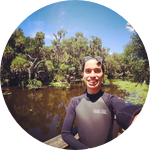About This Project
I am currently working on an undergraduate thesis at University of Central Florida looking to improve community-based living shoreline projects which are rising in popularity as a way to prevent coastal erosion. I will be determining if cultivation salinity and the use of biodegradable mats affect the transplant success of the grass Spartina alterniflora, widely used in these projects. The end goal is to improve on the design and methodology of projects.
Ask the Scientists
Join The DiscussionWhat is the context of this research?
Living shorelines are projects that involve planting natural vegetation and using oysters as breakwaters as opposed to installing artificial infrastructure that tend to have negative impacts on the natural environment. They have been shown to be successful in mitigating erosion and government agencies are advocating for their use in low wave-energy areas. In the Indian River Lagoon Spartina alterniflora is one of the natural plants transplanted at targeted areas for these projects. These transplants at several sites have shown that survival is variable after a year (10%-93%), and lower survival has been attributed to environmental variables such as dislodgement by wave energy, and transplant shock due to salinity changes from cultivation to estuarine conditions is also suspected.
What is the significance of this project?
We expect to determine whether the use of a biodegradable mesh as a stabilizing substrate is effective in increasing the success of Spartina alterniflora transplantation in the field, and whether propagating them under freshwater or estuarine salinity conditions affects their survival once transplanted in the field. This knowledge will serve to improve salt marsh restoration efforts and inform living shoreline stabilization project guidelines. This knowledge will be ultimately useful for management workers, and benefit the community, especially those that benefit from coastal erosion control.
What are the goals of the project?
The end goal is to improve on the design and methodology of these coastal erosion control projects by increasing the success of Spartina alterniflora to reestablish!
Budget
I need enough mesh (20m^2) in order to ground the Spartina alterniflora for two of my treatments, which are replicated five times and two different sites. Jute yarn is used to tie down individual Spartina plugs to the jute mesh mat. Instant Ocean Salt is used to get and maintain the saltwater tubs to a desired salinity. Gallon pots are used to plant Spartina while they are grown under different treatments. And gas is used to get me to the field locations!
Meet the Team
Steven Carrion
Hello Everyone! I am a Ronald E. McNair Scholar in the Interdisciplinary Studies program at the University of Central Florida. I'm majoring in Environmental Studies, Sciences Concentration, and I am an aspiring applied marine ecologist! In the future, I want to work cooperatively with policy makers, local communities, marine resource users, and professionals in varying disciplines to create practical multi-lateral solutions for the restoration and management of estuarine and coastal seas.
I have previously researched the long-term impacts of the Deepwater Horizon oil spill on marine invertebrate communities living in coastal marsh sediments through a National Science Foundation REU experience at LUMCON. I was also involved in the cross-Mediterranean research group, Med-JellyRisk, to research hydroid fouling on aquaculture systems, and the trophic impact of proliferations of the understudied species, Velella velella, in Italy. This involvement has lead to co-authorship on a peer-reviewed paper in the Journal of Plankton Research. I have previously completed an intramurally funded group project on Spartina alterniflora cultivation which is used in shoreline stabilization, and I'm currently working on an undergraduate thesis looking to improve community-based living shoreline stabilization projects by examining factors that influence Spartina alterniflora transplant success. Last year I was nationally recognized through the Morris K. and Stewart L. Udall Foundation for my commitment to a career in academia as a scientist and educator, and my community involvement.
I am also founder and President of the Mad Scientist's Research Society which you can find more information about here: http://madscisociety.org/
Lab Notes
Nothing posted yet.
Additional Information
Some interesting articles!
"Armed with nature, Philippines to boost defenses against stronger storms" "NOAA study finds ‘living shorelines’ can lessen climate change’s effects "
Project Backers
- 4Backers
- 6%Funded
- $18Total Donations
- $4.50Average Donation
